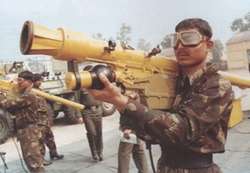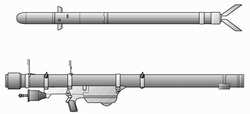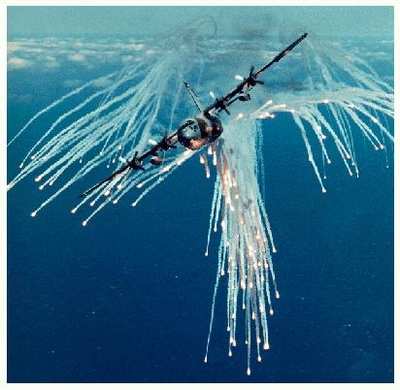DHS Is Working On It
 The Department of Homeland Security,
in partnership with other federal agencies, is taking an aggressive
approach to counter the threat of shoulder-fired missiles to
civilian commercial aviation. Homeland Security's Science and
Technology division is leading the technology aspects of the effort
through its Counter-MAN Portable Air Defense Systems (MANPADS)
Special Program Office. The MANPADS office will help determine the
viability, economic costs and effectiveness of adapting existing
technology from military to commercial aviation use. Following an
aggressive 18-24 month analysis, prototype demonstration and
testing phase, Homeland Security will provide the Administration
and Congress with a recommendation for the most viable solution to
defend against shoulder-fired missiles.
The Department of Homeland Security,
in partnership with other federal agencies, is taking an aggressive
approach to counter the threat of shoulder-fired missiles to
civilian commercial aviation. Homeland Security's Science and
Technology division is leading the technology aspects of the effort
through its Counter-MAN Portable Air Defense Systems (MANPADS)
Special Program Office. The MANPADS office will help determine the
viability, economic costs and effectiveness of adapting existing
technology from military to commercial aviation use. Following an
aggressive 18-24 month analysis, prototype demonstration and
testing phase, Homeland Security will provide the Administration
and Congress with a recommendation for the most viable solution to
defend against shoulder-fired missiles.
The task force says it's adopted a systematic, end-to-end
countermeasures strategy, which is being aggressively implemented
through multiple agency initiatives. The strategy focuses on three
areas:
- Proliferation control and threat reduction
- Tactical measures and recovery
- Technical countermeasures
DHS says the Bush administration has made significant progress
with the international community on proliferation control and
threat reduction. This includes numerous efforts in working with
member countries of the G-8 and other international economic and
industry organizations to adopt an effective global strategy that
will limit proliferation and potential illicit use of MANPADS.
Science and Technology's Counter-MANPADS Special Program Office,
which became operational in early October of 2003, does not intend
to develop new technology, but rather to adapt existing technology
from military to commercial aviation use. This technology
adaptation will also ensure that the resulting countermeasures are
consistent with airport operations and commercial air carrier
logistics that include such activities as maintenance, support, and
training.
The Counter-MANPADS Program has reprogrammed $2 million in FY
2003, had appropriated $60 million in FY 2004, and will request an
additional $60 million in FY 2005, for this development effort.
In early October 2003, the Department of Homeland Security's
Science and Technology division released a solicitation announcing
a "call for proposals" to address this potential threat. The
solicitation is the first step in the Department's two-phase
systems development and demonstration program for anti-missile
devices for commercial aircraft.
 Phase I, which will begin in January
2004, will provide a detailed design and an analysis of the
economic, manufacturing and maintenance issues needed to support a
system that will be effective in the commercial aviation
environment. This phase will last approximately six months and will
end in the selection of one to two contractors moving on to the
next phase.
Phase I, which will begin in January
2004, will provide a detailed design and an analysis of the
economic, manufacturing and maintenance issues needed to support a
system that will be effective in the commercial aviation
environment. This phase will last approximately six months and will
end in the selection of one to two contractors moving on to the
next phase.
Phase II will include development of prototype demonstrations using
existing military or commercial technology which will be subjected
to a rigorous test and evaluation process. Phase II will last
approximately 12 -18 months followed by a recommendation to the
Administration and Congress.
Science and Technology's Counter-MANPADS program held an
Industry Day on October 15, 2003 in Washington, D.C. to describe
the program's procurement process. The conference, hosted by the
Science and Technology division, was attended by over 200
participants from 91 organizations. The Industry Day was an
educational opportunity for potential contractors to learn more
about the Department's Counter-MANPADS solicitation.
Interested contractors were asked to submit White Papers and
Qualifications by late October. Candidates with the most promising
White Papers were invited to present oral proposals to Department
representatives in December. In January 2004, three candidates were
invited to participate in agreement negotiations for the Phase I of
the Counter-MANPADS Program.
Technological Challenges and Costs
 Technologies developed for military
or other specialized purposes are currently incompatible with
commercial air fleet operations. Although underlying military
technologies will be leveraged, the systems must be adapted to meet
commercial operational concepts.
Technologies developed for military
or other specialized purposes are currently incompatible with
commercial air fleet operations. Although underlying military
technologies will be leveraged, the systems must be adapted to meet
commercial operational concepts.
One likely technology that has been identified for potential
commercial use is the so-called Directed InfraRed CounterMeasure
(DIRCM), an infrared device that jams missile guidance systems.
Current DIRCMs cannot be easily adapted to the US commercial air
fleet, and must be re-engineered. The current available DIRCMs have
roughly 300 hours of life before they must be repaired or
refurbished. While suitable for the military or special purpose
aircraft, given their maintenance and logistical infrastructure,
this is not suitable for US commercial air fleet use. The cost of
the training, ground support equipment, supplies and spares, and
logistics trail that would need to be in place at every US airport
would be prohibitive. Estimates put this cost at as much as $5
billion to $10 billion per year, a burden that the US commercial
air carrier industry cannot bear.
 Military missile countermeasures,
such as the Large Aircraft InfraRed CounterMeasure (LAIRCM) unit,
which uses Directed InfraRed CounterMeasure (DIRCM) techniques,
exist in various stages of development and initial fielding. The
LAIRCM system defeats the threat missile guidance system by
directing a high-intensity modulated laser beam into the missile
seeker. However, these technologies are generally utilized by
military and Heads-of-State aircraft that have the operations and
maintenance infrastructure to support the systems.
Military missile countermeasures,
such as the Large Aircraft InfraRed CounterMeasure (LAIRCM) unit,
which uses Directed InfraRed CounterMeasure (DIRCM) techniques,
exist in various stages of development and initial fielding. The
LAIRCM system defeats the threat missile guidance system by
directing a high-intensity modulated laser beam into the missile
seeker. However, these technologies are generally utilized by
military and Heads-of-State aircraft that have the operations and
maintenance infrastructure to support the systems.
The defense industry has performed limited evaluation of
tower-mounted InfraRed CounterMeasure (IRCM) subsystems for
ground-based applications as an alternative to airborne
installation. IRCM commercialization requires tightly integrated
systems engineering and development, as well as testing and
evaluation of existing and emerging military equipment. Efforts to
transition IRCM systems to civilian use face several limitations.
The primary challenges are:
- Achieving an affordable total cost of ownership;
- Improving reliability over their military counterparts;
- Performing less labor and time-intensive maintenance
interventions;
- Decreasing false alarm rates
- Ensuring that these devices can be safely applied in operating
environments of civilian aircraft.
When evaluating the deployment of IRCMs aboard civilian
aircraft, it is also important to consider the effects of using
these countermeasures in civilian airspace, specifically, in
populated areas. In the event of a MANPADS launch, traditional
military pyrotechnic countermeasures (flares) represent a major
safety hazard to property and personnel. Directed countermeasures,
such as an on-board laser to disrupt the MANPADS sensor and steer
the missile away from the aircraft, appear to be the most promising
candidates for application to civilian aircraft. However, new
pyrotechnic and pyrophoric technologies may be adaptable to
commercial operations, which will be analyzed in Phase I.

While it is conceivable that existing military IRCM units could
be re-engineered for civilian aircraft use, many technical and
operational tradeoffs have not been performed to address risks of
such approach. For example, there is an established military
logistics infrastructure that serves airborne countermeasure
equipment, spanning functions from pilot training and routine
maintenance to spare parts and depot repair. A similar
infrastructure would be costly and time-consuming to replicate in
the commercial airline industry.
It would be premature to integrate currently available military
IRCM equipment aboard civilian aircraft due to numerous issues
concerning aircraft modification and certification, maintenance and
supportability, and operational employment. Even if IRCM equipment
were retrofitted on only the Civil Reserve Air Fleet, safety of
flight and IRCM operational issues abound because rigorous
analytical processes have not been performed.
Partnerships
Department leadership is committed to working with the key
stakeholders involved in the potential deployment of a
Counter-MANPADS system.
Transportation Security Administration - conduct vulnerability
assessments and work with law enforcement officials to reduce risks
at major airports
- Department of State - counter proliferation of shoulder-fired
missiles
- Federal Aviation Administration - certification of technology
for commercial use
- Department of Defense - provide expert advise on military
technology
Science and Technology staff members have a working relationship
with representatives of the safety, operations, and maintenance
areas of the Federal Aviation Administration, who are key to the
success of this development and demonstration program.
The Department's effort also includes significant contributions
from pilots, airport operators, airlines, and ground maintenance
professionals. This industry input will ensure that lifecycle
costs, including acquisition, integration, operation and support
will be analyzed, giving all stakeholders an understanding of the
total costs associated with any potential system.
 ANN's Daily Aero-Term (04.14.24): Maximum Authorized Altitude
ANN's Daily Aero-Term (04.14.24): Maximum Authorized Altitude ANN's Daily Aero-Linx (04.14.24)
ANN's Daily Aero-Linx (04.14.24) Classic Aero-TV: 'We're Surviving'-- Kyle Franklin Describes Airshow Life 2013
Classic Aero-TV: 'We're Surviving'-- Kyle Franklin Describes Airshow Life 2013 Aero-News: Quote of the Day (04.14.24)
Aero-News: Quote of the Day (04.14.24) Airborne 04.09.24: SnF24!, Piper-DeltaHawk!, Fisher Update, Junkers
Airborne 04.09.24: SnF24!, Piper-DeltaHawk!, Fisher Update, Junkers







